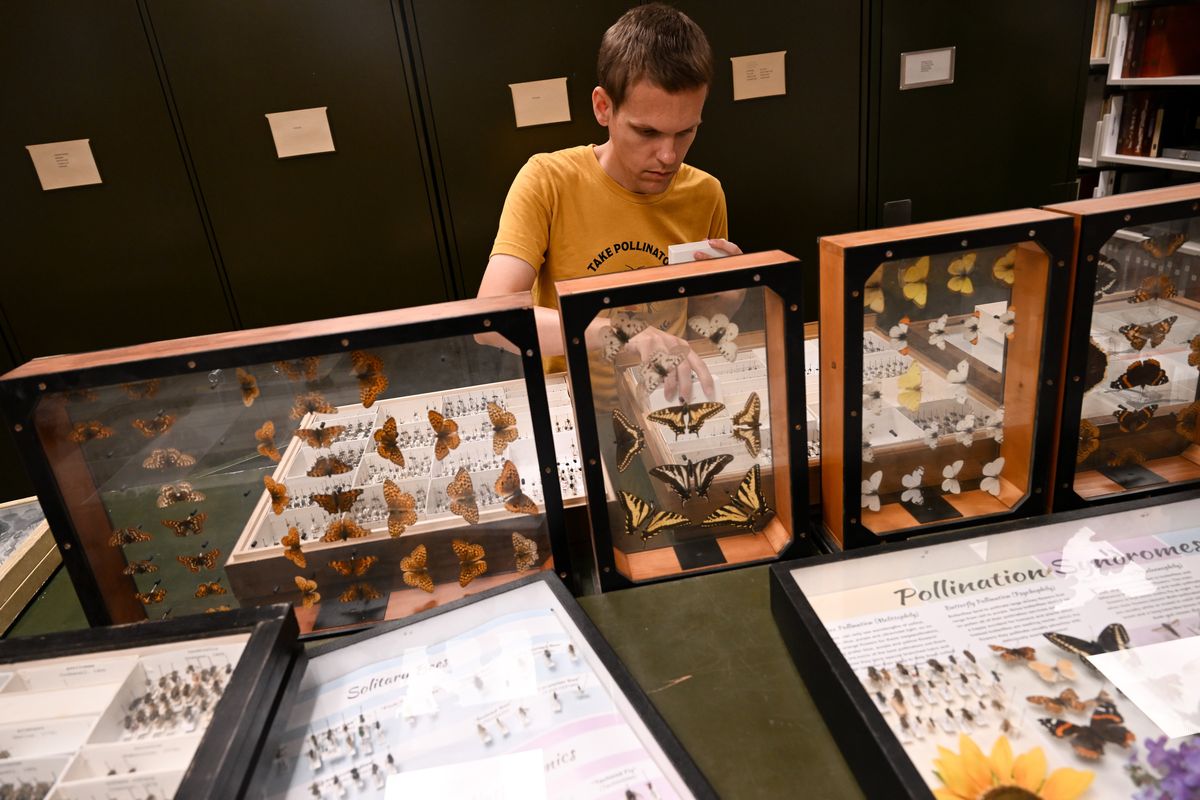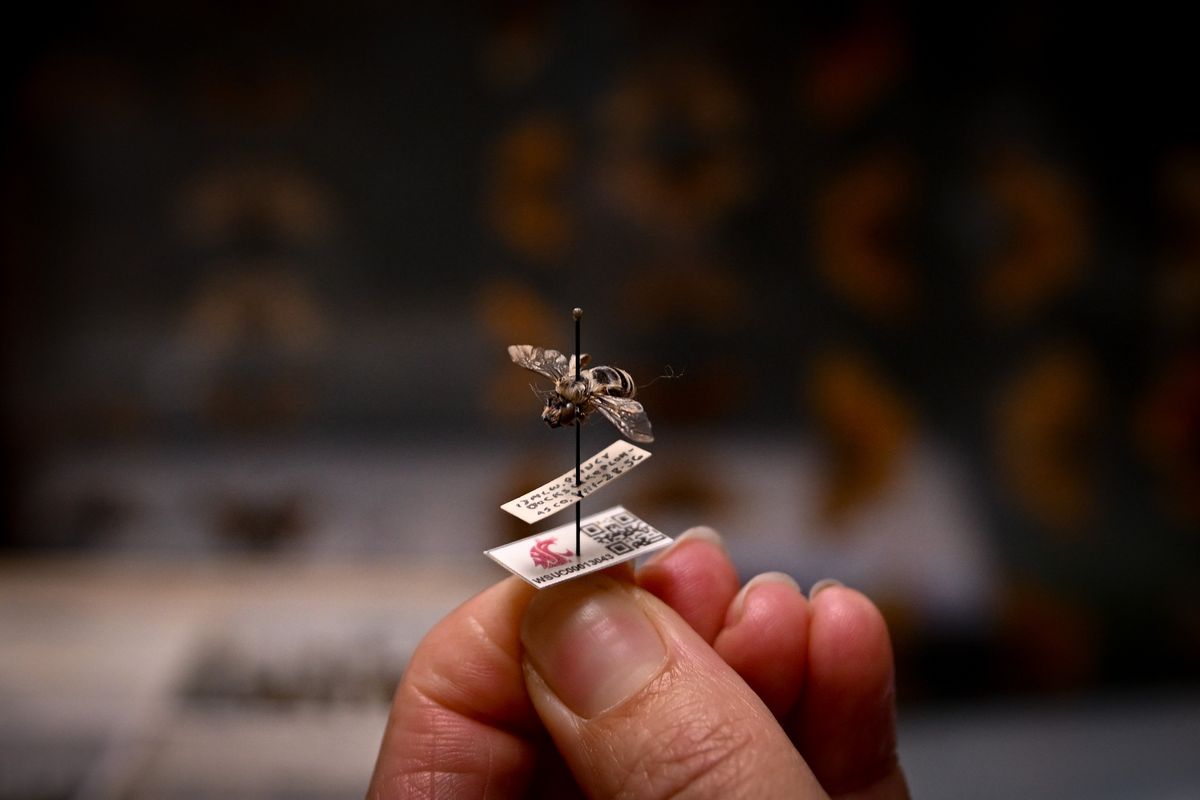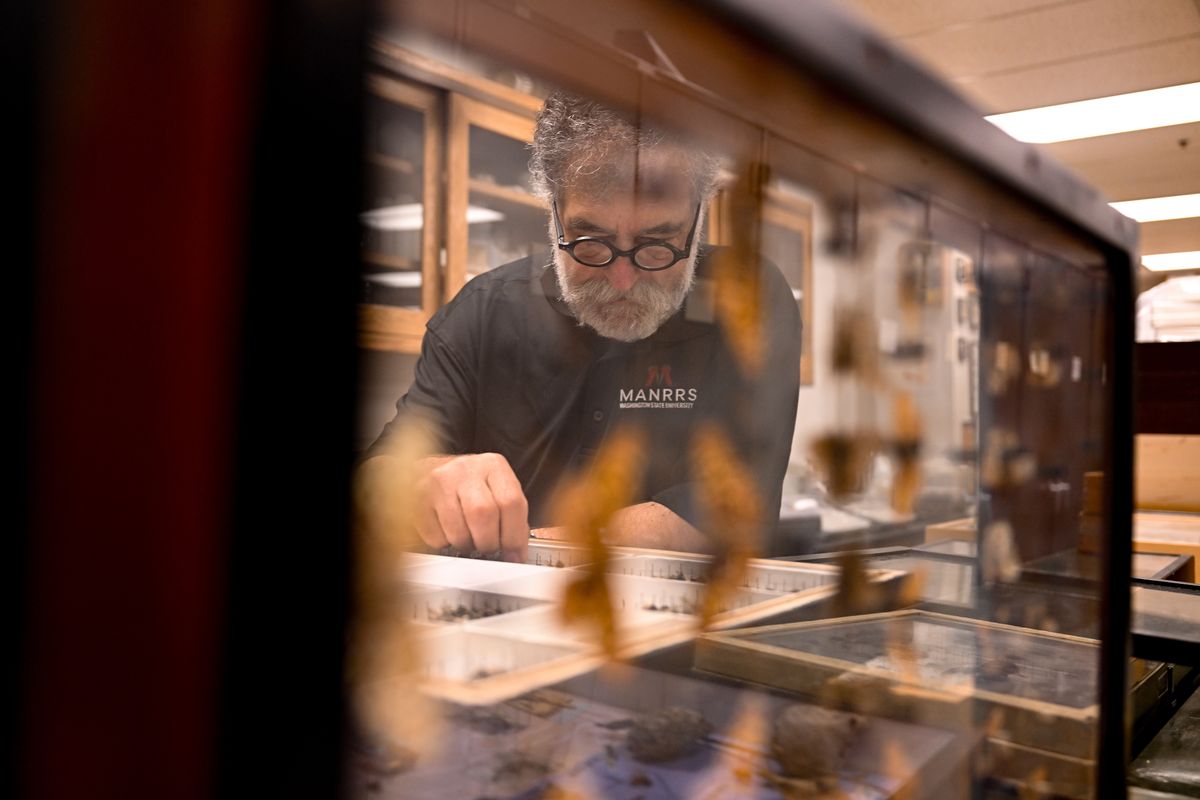WSU makes strides in digitalizing 3 million insect collection
Dr. Elizabeth Murray holds a bee while showing a new QR code tagging system WSU is using in their collection on Monday, Aug. 5, 2024, at The M.T. James Entomological Collection in Pullman, Wash. The school is working to produce a “Bee Atlas” for bees in the state of Washington. (Tyler Tjomsland/The Spokesman-Review)
There are 3 million insects in an inconspicuous room on Washington State University’s campus.
Completely filling row after row of metal cabinets, each individual specimen is pinned and labeled with what it is and where it was caught. Of the millions, 30,000 bees are being digitized with funding from a 2022 legislative decision.
Housing insects collected from as long ago as the 1880s, WSU’s M.T. James Entomological Collection is the largest insect museum in the Pacific Northwest, according to its director, Elizabeth Murray, and curator, Richard Zack.
“Our history of people that have been here over 100 years have been mainly fly-people, so we have a really good collection of flies. Over the last 50 years, we’ve had a lot of moth-people, so we have a real good collection of moths,” Zack said. “And now, we’re building a really good collection of bees.”
Bees have been a hot insect around the globe in recent years. Zack said a lot of their rise in the public eye had to do with the economical importance of honey bees, Zack said.
“And, I think people just like certain types of insects. And for whatever reason, they like bees,” he said.
But as popular attention shifted to the honeybee, Murray said that there became a greater awareness of the importance of other kinds of bees. In recent work, museum employees have estimated that there are more than 600 species of bees in Washington.
“I think people are realizing the value of pollination services from native bees,” Murray said. “A lot of bees do have host plant specialization, so that plant really does depend on a bee species in order to pollinate it and produce fruit and seeds and all that.”
In 2021, a bill was passed in Washington increasing funding for outreach, education, habitat creation, and protections for and about pollinators. The WSU insect museum received $50,000 from this bill in 2022 to digitize information on the roughly 30,000 bees in the collection, making them available for public use. So far, 25,000 have been digitalized and 9,000 have made it online as part of a program called the Washington Bee Atlas, Murray said.
Though only bees have been digitalized, Murray said the hope is to extend the project to the entire 3 million insect collection. Getting such a large dataset online and publicly available would help to facilitate information sharing with both other researchers and the general population, said Laura Lavine, head of the WSU Entomology Department.
“Without digitalization, people have to visit or they have to request the specimens and that’s not really available to just any person,” Lavine said. “It’s still highly specialized records and highly specialized data, but much, much more accessible for public impact and public support than in the past.”
Zack gave an example of the sorts of hoops individuals have to jump through to get information on the nondigitalized insects in the collection.
“We work with colleagues all over the world and they’ll write to us and say, ‘OK, so you’re an expert in so and so, can we send Joel all of our bees to look at?’ And we’ll write them and say, ‘Yeah, but will you look at all of our whatever?’ ” Zack said.
Though the collection focuses primarily on insects found in the Pacific Northwest, WSU also boasts one of the most extensive collections of Guatemalan insects, with around a quarter of a million specimens having been brought back from exhibitions by Zack and WSU students.
“That material is really important because for people around the world that are working on certain groups that need specimens from Guatemala, we’re one of the go-to places,” Zack said.
Though the extensive nature and age of the collection makes its digitalization a challenge, it also makes it all the more important to complete, the collection’s manager, Joel Gardener, said.
“We’re kind of like a data repository for information that you can’t get anymore,” Gardener said. “If there’s a fly on your apple and you want to know, ‘Is this new?’ … You can’t figure that out unless you go to a collection like this and then look at the old specimens and go through them.”
Zack said the versatility of insects is what makes them important to understand.
“All mosquitoes are not created equally. What mosquitoes vector certain disease? What aphids feed on wheat? What aphids feed on tree fruits?” Zack said.
“Insects do things very, very differently, and I think that’s where a lot of this information comes in.”
The M.T. James Entomological Collection is organized for researching purposes, bit Lavine said the department hopes to transform it into a more user friendly and publicly visible museum.
“There’s a lot to see, but it’s not on display,” Lavine said.
She added that if more people knew about the collection, it could spur fundraising to put the collection on public display.
The museum offers tours to the public upon request, sometimes bringing in live insects for people to hold.
The Washington Bee Atlas project, which staff have been contributing to as part of their digitalization efforts, is volunteer run.
For other ways to get involved, contact Murray directly at e.murray@wsu.edu.
“As a state-funded institution,” Lavine said, “we’re trying to do more with less and we’re trying to make sure that people know that we are a resource.”





